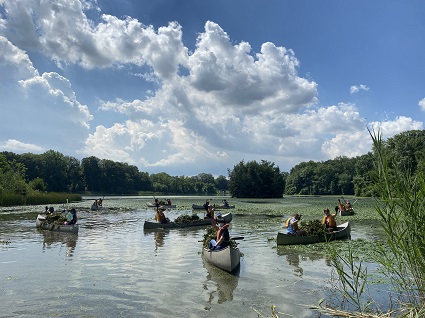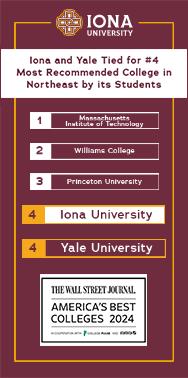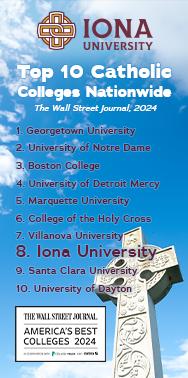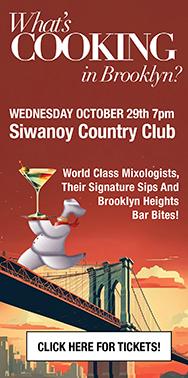Help Improve the Local Ecology by Reducing Invasive Species

By Ellen Edwards, Chair, Bronxville Green Committee
Aug. 12, 2020: Recently, I spent five separate mornings in a canoe, wet through and filthy, pulling endless numbers of the invasive plants called water chestnut from three different lakes. Water chestnut is a large rosette plant with yards of long, tangled roots. By the end of each expedition, my mask was dark with dirt, leaf mold was clinging to my arms, and my sneakers were full of muck. I felt great!
Removing 15 Truckloads of Water Chestnuts

I was part of a team of volunteers helping the Westchester Parks Foundation remove this invasive aquatic plant from lakes in Blue Mountain Reservation in Peekskill, Eastchester's Twin Lakes, and Tibbetts Brook Park in Yonkers.
Led by Erin Cordiner, Director of Volunteer Programs, and Adam Lippman, Volunteer Coordinator, we hoped to make a dent in vegetation that completely covered most of the lakes' surfaces, limiting fishing and making boating impossible.
Water chestnuts were robbing each lake of light and oxygen essential for its continued existence. Without our help, no native plants would survive, depriving the lake of food for fish and other aquatic life.
Although our efforts didn't seem to make much of a dent in the thick mat of vegetation, Erin assured us our hard work was an important part of a multi-year effort. She said that eradicating the water chestnut would take ten to twelve years, but as long as much of it was cleared out each year, we'd be making progress.
At Tibbetts Brook Park, Erin said, "The ultimate goal is to bring back this lake, to restore it for ecological reasons and for the community."
This summer, Erin estimated that her teams had removed fifteen truckloads of water chestnut rosettes--thousands and thousands of plants. Each of these plants had the potential to drop twenty seeds into the lake bottom, where each could produce up to twenty more seeds. Hundreds of volunteers had made this possible.
After spending months inside, too much of it in front of a computer, I welcomed the opportunity to be outside in attractive settings doing physical labor that, unlike my indoor exercise routine, served a useful purpose.
I'd felt similarly tired but exalted a couple of weeks earlier after spending three hours in Rye's Read Sanctuary (next to Playland), pulling the invasive land plants mugwort, porcelain berry, and knotweed. We filled 44 large garbage bags with plant material, and
Erin assured us that whatever invasives returned to the area that we had cleared would be weakened. I felt energized and eager to invite others to join the effort.
What Invasive Plants Do to the Ecology

Plants native to our area have evolved to fit our particular soil, temperature, and general ecology. They work together to fill different ecological niches, resulting in a healthy diversity. They are uniquely suited to provide our local insects, birds, and animals with the specific habitat and food they need. The rich variety of native plants makes the ecology of the area more resilient. If one plant dies off for whatever reason, many others remain to fill in.
In contrast, invasive plants come from somewhere else. They have not evolved to fit our particular ecology; instead, they often come to dominate it, wiping out the native plants as they ferociously reproduce. Local insects and animals lose their food and habitat. We lose the pleasure of a multitude of plants, each with its own delights.
Westchester County has a serious problem with invasive plants. You can see a blanket of vines shrouding trees and shrubs from most local highways. These vines are invasive species choking out the native vegetation.
Unless action is taken to kill invasive vegetation, the plants that they are matting and strangling will eventually die. Invasive species are a visible sign of an unhealthy ecology. Yet the evidence of the full range of invasive species is often not always visible.
On a webinar produced by the New York State Department of Environmental Conservation (DEC), I learned that invasives can include animals, insects, and pathogens as well as plants. These include the emerald ash borer. Since there is no defense against this invasive insect, it's expected that most ash trees in North America will eventually die. This will adversely affect the ecological health of our forests for decades to come. Wood from Ash Trees has long been used to make furniture and baseball bats. Indigenous people in New England use ash splits in the ancient art of basket weaving.
Where Invasive Species Comes From
Controlling the spread of invasive species is notoriously difficult.
International trade is a big culprit. Invasives of all kinds hitch rides on cargo containers. They are in the ballast water that's pumped into local waterways before a full load of cargo is taken aboard, on the hulls of private boats, and even on your own possessions as you move from one region to another.
Wooden pallets used in shipping often harbor invasive insects. Even firewood taken from an upstate vacation home to a main residence down-state can transport invasive insects or seeds. A state law banning the transport of firewood more than fifty miles attempts to address this concern.
The plant nursery trade is often a source of invasives. Ornamental plants that look lovely in a home's landscaping sometimes originate far away. They can spread far beyond residential borders into parkland and forests, where they lack predators and other deterrents. Often such plants can survive in a wide geographical range. For example, a plant that can tolerate salt might thrive along highways where salt is used for snow and ice removal. Like the water chestnut, some invasives also have a reproductive advantage.
When people dump the contents of aquariums into rivers and lakes, they also disturb the ecosystem. In some parts of Westchester, native fish are now competing with aquarium-raised goldfish for food and space.
How We Can Help Reduce Invasive Species
The DEC and the Westchester Parks Foundation can't do much about the birds, animals, and wind that spread the seeds of invasive plants, but they're encouraging us to help address the problem in the following ways:
-Respect regulations aimed at limiting inadvertent human transportation of invasives. These regulations include the rule about firewood and the requirement that watercraft (including all water gear such as paddleboards and diving equipment) be thoroughly cleaned, drained, and dried before entering a new water body.
The same goes for hiking and camping gear. Footwear, clothes, and all camping and hiking gear should be cleaned as soon as the campers or hikers get home and well before the equipment is used on another outing.
-Plant native species in our yards. Be sure to examine all random seed mixes to make sure they don't include potential invasives.
-Don't release exotic pets and plants into the natural world.
-Consider joining a local chapter of the Partnership for Regional Invasive Species Management (PRISM).
-Check out iMapInvasives, an online and phone app on which sightings of invasive species can be reported. This enables you to become a citizen scientist to help experts plot the range and prevalence of specific species.
The NYS DEC prohibited plant list consists of 69 invasive plants. They include common plants that may surprise you, including the Norway maple, honeysuckle, Japanese barberry (which harbors ticks and their mouse carriers), burning bush, and winged euonymous.
Brian Eshenaur of Cornell's New York State Integrated Pest Management Program recommends a list of alternatives for your yard. They include:
-Weigela, also known as Midnight Wire
-Ninebark, both the Diablo and Little Devil varieties
-A specific cultivar of Japanese barberry that produces no fruit
-Pagoda dogwood
-Witch hazel (which blooms in very early spring)
-Bottlebrush buckeye (which flowers in mid-summer)
-big bluestem
-Northern bayberry (which is also salt and deer resistant)
-Holly (including a deciduous variety)
-Inkberry holly
-American arborvitae (but the deer do eat this one)
-Red osier dogwood (which has gorgeous red branches in winter)
-Chokeberry
-Fothergilla (with its pretty blooms and red fall color).
Helping the Westchester Parks Foundation
The Westchester Parks Foundation, a nonprofit organization, welcomes volunteers all year. For details and to register, go to thewpf.org/. Please consider joining them!
You may find that pulling invasive plants is a perfect way to stay safe while working with others in a fun, satisfying outdoor activity.
And if you're not quite ready for that level of adventure, you might consider making a donation. Volunteer projects like those I joined would not be possible without generous contributions to pay for canoes, life vests, and other equipment. There's even a mechanical harvester that effectively and quickly removes water chestnuts from lake surfaces, but it's expensive.
With additional support, the Westchester Parks Foundation hopes to use it more often. That would help enormously in permanently eradicating the water chestnut from Tibbetts Brook Park.
The Westchester Parks Foundation's limited staff maintains 50 parks, runs programs, and raises funds. It's a herculean effort, but with more people enjoying our local parks during the coronavirus pandemic, we can all be more appreciative of the vital role our parks play in contributing to our health and enjoyment.
To learn more:
Click here for details on native/invasive plants, how to clean your boat, and how to be a responsible pet owner:
Cornell's New York State Pest Management Program
Photos courtesy of The Westchester Parks Foundation
Editor's note: As a public service, MyhometownBronxville publishes articles from local institutions, officeholders, and individuals. MyhometownBronxville does not fact-check statements therein, and any opinions expressed do not necessarily reflect the thinking of its staff.
Government & History Directory
Bronxville is a quaint village (one square mile) located just 16 miles north of midtown Manhattan (roughly 30 minutes on the train) and has a population of approximately 6,500. It is known as a premier community with an excellent public school (K-12) and easy access to Manhattan. Bronxville offers many amenities including an attractive business district, a hospital (Lawrence Hospital), public paddle and tennis courts, fine dining at local restaurants, two private country clubs and a community library.
While the earliest settlers of Bronxville date back to the first half of the 18th century, the history of the modern suburb of Bronxville began in 1890 when William Van Duzer Lawrence purchased a farm and commissioned the architect, William A. Bates, to design a planned community of houses for well-known artists and professionals that became a thriving art colony. This community, now called Lawrence Park, is listed on the National register of Historic Places and many of the homes still have artists’ studios. A neighborhood association within Lawrence Park called “The Hilltop Association” keeps this heritage alive with art shows and other events for neighbors.
Bronxville offers many charming neighborhoods as well as a variety of living options for residents including single family homes, town houses, cooperatives and condominiums. One of the chief benefits of living in “the village” is that your children can attend the Bronxville School.
The Bronxville postal zone (10708, known as “Bronxville PO”) includes the village of Bronxville as well as the Chester Heights section of Eastchester, parts of Tuckahoe and the Lawrence Park West, Cedar Knolls, Armour Villa and Longvale sections of Yonkers. Many of these areas have their own distinct character. For instance, the Armour Villa section has many historic homes and even has its own newsletter called “The Villa Voice” which reports on neighborhood news.
Link to Village of Bronxville One Square Mile Monthly Newsletter
Village of Bronxville Administrative Offices
337-6500
Open 9:00am - 4pm excluding holidays and weekends
Bronxville Police Department
337-0500
Open 24 hours
Bronxville Parking Violations
337-2024
Open 9:00am - 4pm excluding holidays and weekends
Bronxville Fire Deparment
793-6400


















